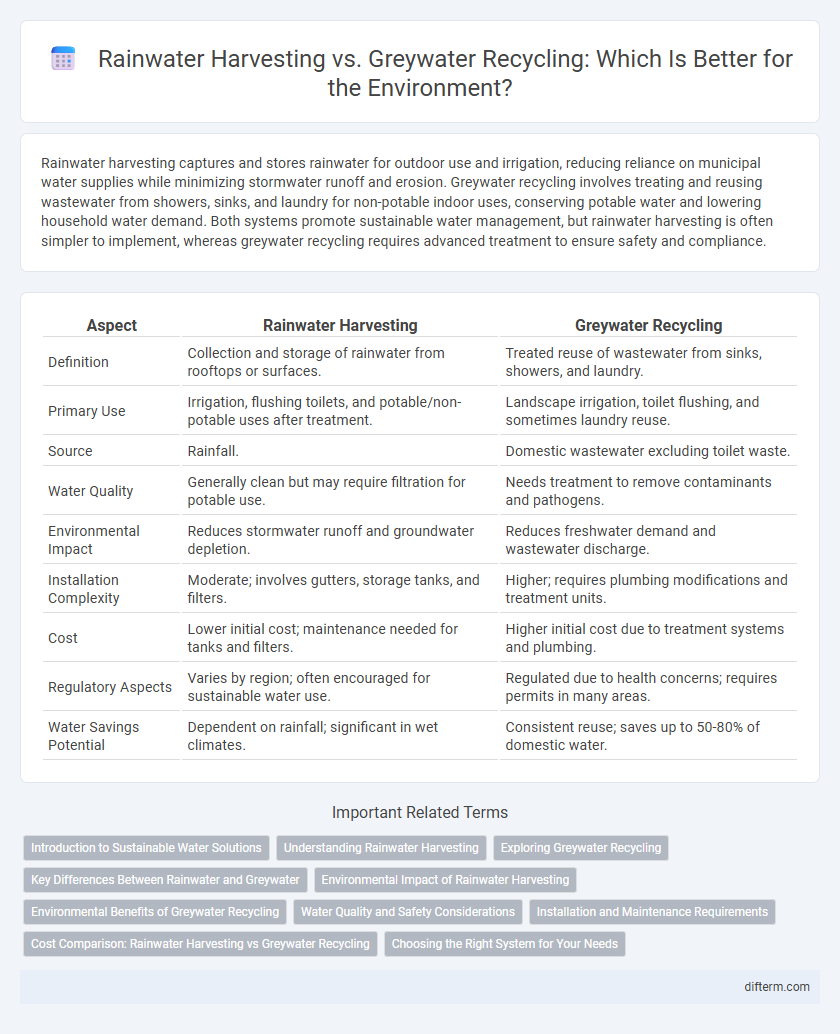Rainwater harvesting captures and stores rainwater for outdoor use and irrigation, reducing reliance on municipal water supplies while minimizing stormwater runoff and erosion. Greywater recycling involves treating and reusing wastewater from showers, sinks, and laundry for non-potable indoor uses, conserving potable water and lowering household water demand. Both systems promote sustainable water management, but rainwater harvesting is often simpler to implement, whereas greywater recycling requires advanced treatment to ensure safety and compliance.
Table of Comparison
| Aspect | Rainwater Harvesting | Greywater Recycling |
|---|---|---|
| Definition | Collection and storage of rainwater from rooftops or surfaces. | Treated reuse of wastewater from sinks, showers, and laundry. |
| Primary Use | Irrigation, flushing toilets, and potable/non-potable uses after treatment. | Landscape irrigation, toilet flushing, and sometimes laundry reuse. |
| Source | Rainfall. | Domestic wastewater excluding toilet waste. |
| Water Quality | Generally clean but may require filtration for potable use. | Needs treatment to remove contaminants and pathogens. |
| Environmental Impact | Reduces stormwater runoff and groundwater depletion. | Reduces freshwater demand and wastewater discharge. |
| Installation Complexity | Moderate; involves gutters, storage tanks, and filters. | Higher; requires plumbing modifications and treatment units. |
| Cost | Lower initial cost; maintenance needed for tanks and filters. | Higher initial cost due to treatment systems and plumbing. |
| Regulatory Aspects | Varies by region; often encouraged for sustainable water use. | Regulated due to health concerns; requires permits in many areas. |
| Water Savings Potential | Dependent on rainfall; significant in wet climates. | Consistent reuse; saves up to 50-80% of domestic water. |
Introduction to Sustainable Water Solutions
Rainwater harvesting captures and stores precipitation for non-potable uses, reducing dependency on municipal water and mitigating stormwater runoff. Greywater recycling treats and reuses water from sinks, showers, and laundry for irrigation and toilet flushing, lowering freshwater consumption. Both methods enhance sustainable water management by conserving resources and minimizing environmental impact.
Understanding Rainwater Harvesting
Rainwater harvesting captures and stores rainwater from rooftops or other surfaces for non-potable uses, reducing reliance on municipal water supplies and minimizing stormwater runoff. Systems typically include catchment areas, filtration units, and storage tanks, enabling efficient water reuse for irrigation, flushing toilets, and cleaning. Compared to greywater recycling, rainwater harvesting provides a renewable source free from domestic contaminants, making it a vital strategy for sustainable water management and conservation.
Exploring Greywater Recycling
Greywater recycling significantly reduces freshwater consumption by reusing water from baths, sinks, and laundry for irrigation and toilet flushing, offering a sustainable alternative to rainwater harvesting in urban settings. This method lowers household water bills and decreases the strain on municipal wastewater systems, promoting efficient resource management. Implementing greywater systems enhances drought resilience and supports green infrastructure projects by maintaining soil moisture and reducing runoff pollution.
Key Differences Between Rainwater and Greywater
Rainwater harvesting captures and stores rain from rooftops or surfaces for non-potable uses, while greywater recycling treats wastewater from showers, sinks, and laundry for reuse in irrigation or flushing toilets. Rainwater is typically low in contaminants but may require filtration and disinfection, whereas greywater contains household chemicals and needs advanced treatment processes. Both methods reduce freshwater demand and promote sustainable water management but differ in source, treatment complexity, and potential applications.
Environmental Impact of Rainwater Harvesting
Rainwater harvesting significantly reduces stormwater runoff, decreasing soil erosion and minimizing pollution in aquatic ecosystems. By capturing and reusing rainwater, this practice lessens dependence on groundwater and municipal water supplies, contributing to sustainable water management. It also helps mitigate urban heat island effects and supports biodiversity by restoring natural water cycles in urban areas.
Environmental Benefits of Greywater Recycling
Greywater recycling significantly reduces freshwater consumption by reusing water from baths, sinks, and laundry for irrigation and toilet flushing, lowering the demand on groundwater and municipal supplies. This process helps reduce wastewater discharge into sewers and natural water bodies, decreasing pollution and the burden on treatment plants. By conserving water and minimizing contaminants, greywater recycling supports sustainable water management and promotes healthier ecosystems.
Water Quality and Safety Considerations
Rainwater harvesting collects natural precipitation, which can contain contaminants such as dust, bacteria, and pollutants, requiring filtration and disinfection to ensure safe water quality. Greywater recycling involves reusing wastewater from sinks, showers, and laundry, which contains organic matter and chemicals, necessitating advanced treatment processes to remove pathogens and harmful substances. Both methods demand strict monitoring and maintenance to prevent health risks and ensure compliance with safety standards.
Installation and Maintenance Requirements
Rainwater harvesting systems typically require rooftop catchment areas, gutters, storage tanks, and filtration units, with installation complexity varying by scale. Maintenance involves regular cleaning of tanks and filters to prevent clogging and contamination. Greywater recycling systems necessitate plumbing modifications for wastewater diversion, specialized filtration and treatment units, and more frequent monitoring to ensure safe reuse for irrigation or flushing.
Cost Comparison: Rainwater Harvesting vs Greywater Recycling
Rainwater harvesting systems typically incur lower upfront costs compared to greywater recycling due to simpler filtration and storage requirements, often ranging from $1,500 to $3,000 for residential setups. Greywater recycling involves complex plumbing modifications and advanced treatment processes, which can increase installation expenses to between $2,000 and $5,000. Operational and maintenance costs for greywater systems tend to be higher over time due to frequent filter replacements and system monitoring, while rainwater harvesting generally requires minimal ongoing expenses.
Choosing the Right System for Your Needs
Rainwater harvesting captures and stores rain for outdoor irrigation and non-potable indoor use, reducing dependence on municipal water and lowering utility bills. Greywater recycling treats water from showers, sinks, and laundry to reuse for toilet flushing and landscaping, offering a constant supply independent of rainfall. Selecting the right system depends on water availability, intended usage, installation costs, and local regulations to maximize environmental and economic benefits.
rainwater harvesting vs greywater recycling Infographic

 difterm.com
difterm.com